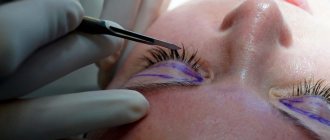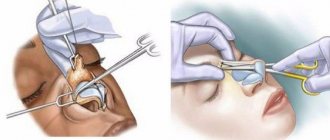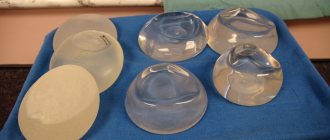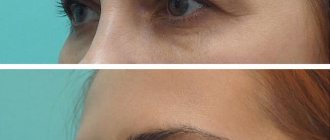The nose is the most pronounced part of the face, thanks to which the face can change beyond recognition. The part of the skin located between the nostrils is called the columella and greatly influences the appearance of the nose. Also, this small part of the nose is very important for the breathing process to be normal, and for this, it performs important functional tasks. During rhinoplasty , the columella is often corrected in order to remove an aesthetic defect and create a harmonious nose.
What defects can columella rhinoplasty correct?
Correction of nasal columella is usually needed when the patient is unhappy with his appearance. However, the column also performs a supporting function, and its curvature can interfere with breathing. In the latter case, the operation is performed for medical reasons.
Typically, plastic surgery allows you to lower or raise the nasal columella that is too high, correct the nasolabial angle, and eliminate the effect of a “hanging” bridge due to a too long septum or incorrect location of the wings.
Indications:
- the column is too high or low;
- irregular nasolabial angle;
- flattened or too wide column;
- bent lintel;
- "hanging" columella.
Contraindications:
- dental diseases;
- blood clotting disorder;
- pregnancy and lactation;
- oncology;
- diabetes;
- exacerbation of chronic diseases;
- acute infections in the body;
- infections and injuries in the intended area of intervention;
- complex pathologies of the nose.
What should a columella look like?
A small area of skin called the nasal columella plays a huge role in the perception of the nose as a harmonious part of the human face. A beautiful columella should have the following qualities:
- its width should not exceed 5-7 mm;
- the angle between the nose and lip should be about 100 degrees for women, 95 degrees for men;
- the column should not sag;
- when looking at the face from the front, the columella should be located lower than the wings of the nose;
- the nostrils should be symmetrical.
If these rules are ignored, any rhinoplasty will not be successful. The nose will look disharmonious, and the person may undergo repeated plastic surgery. While in other cases, a simple correction operation can give a more pronounced result.
Preparing for surgery
At the first consultation, the doctor collects anamnesis and listens to the patient’s wishes and complaints. An examination is carried out, rhinoscopy or endoscopy is performed. Next, a computer model is compiled so that you can see the expected result in advance. If the patient agrees with the surgeon, examinations and tests are prescribed.
Basic preparation steps:
- taking urine and blood tests, including ELISA;
- X-ray examination of the bones of the facial skeleton, ECG, fluorography, and, if necessary, CT;
- consultations with a dentist, therapist, anesthesiologist, otolaryngologist;
- test for local anesthesia or general anesthesia.
General recommendations in the preoperative period:
- stop taking blood thinners two weeks before surgery;
- per week - giving up alcohol and smoking or reducing the number of cigarettes smoked by half;
- three to five days before surgery – stop taking vitamin E;
- two days in advance - giving up coffee and tanning;
- 8-10 hours before – last meal and water.
Memo for preparing for rhinoplasty: tests, prohibitions, recommendations
Do you need anesthesia?
The need for anesthesia during surgery is determined by the amount of work that will be performed by the surgeon. If the doctor plans to simply excise excess tissue, thereby raising the nasal column to the required height, local anesthesia can be used. For large-scale surgery, it is better to use general anesthesia.
The advantages of anesthesia for rhinoplasty can be indicated by at least two arguments:
- the patient, while in a medicated sleep, does not experience anxiety, is not able to make involuntary movements, in other words, to prevent the surgeon from performing “jewelry” work on his face;
- with general anesthesia, the need to use local anesthetics is reduced, so the doctor has the opportunity to work with “living” tissues, rather than injected with various drugs.
To find out whether anesthesia is needed in a particular case, it is better to consult a doctor. Assessing the scale and duration of the proposed work, as well as the degree of pain of the manipulations, he must recommend to the patient the most suitable option for a particular operation.
Progress of the operation
The procedure lasts 30-40 minutes and can be performed under general anesthesia or local anesthesia. The columella may be enlarged or reduced. The bridge is enlarged by transplantation and reduced by partial excision of tissue. One of the correction options is changing the shape of the tip of the nose. The nasal column can be enlarged by installing implants from the patient’s own cartilage, by suturing the medial crura of the wing cartilages, or by introducing autologous fat (lipofilling).
When the nasolabial angle is smoothed, the column is partially excised or the edges of the quadrangular cartilage are resected. If the angle is sharpened, then the nasal bridge is enlarged with expanding grafts or by applying sutures to the cartilages of the wings.
Columella problems
What problems can there be with the columella to require plastic surgery of the nose - rhinoplasty?
Based on what a columella should look like, ideal in size and shape, we can identify the problems that potential plastic surgeon patients most often encounter:
- the nasal column sags;
- the columella is located too high;
- the angle between the nose and lip is too large, or, on the contrary, small.
A person may regard his nose as too wide, with a curved tip, or snub. But in order to correct your appearance, you do not need to undergo complex and traumatic operations to change the contours of the back or its tip. Simply changing the nose column is enough.
Rehabilitation period
After surgery, a plastic or plaster retainer is placed on the nose and must be worn for two weeks. 1.5-2 hours after the procedure you can drink a little. Patients begin eating after 3-4 hours with liquid and warm meals. During rehabilitation, you need to exclude too hot or too cold foods, coffee, salty foods, and alcohol.
For several days, swelling persists, bruising is present, and the operated area loses sensitivity. After 1-2 weeks, the most obvious manifestations of the recent operation disappear, and patients can return to work. The swelling lasts for several more weeks, but visually it is almost invisible. A slight swelling of the tip of the nose persists for several months. The result will finally stabilize after a year.
Recommendations for the recovery period:
- sleep on your back on two pillows;
- sneeze with your mouth open, do not cry, do not laugh, do not blow your nose;
- do not sunbathe;
- stop wearing glasses for several months;
- do not overheat - avoid baths, saunas, hot tubs;
- minimize the risk of infection - do not swim in natural and artificial reservoirs or pools;
- exclude any physical activity for a month, heavy exercise for 1.5 months;
- do not wear clothes that are pulled over the head and have a narrow neck.
Nasal columella plastic surgery is a simple but effective operation that can relieve the patient from a number of defects - congenital or acquired.
Makarov Andrey Vitalievich
Certified specialist in plastic surgery, maxillofacial surgery, otolaryngology, general surgery. Participant in master classes on facial plastic surgery and rhinoplasty in Russia and abroad.
Useful tips
It is quite possible to reduce the risk of unsuccessful intervention if you remember the plastic surgeon’s brief instructions for the patient.
- Choosing a doctor is half the battle. It is important to choose a specialist who will have experience in correcting noses with just such aesthetic defects. Of course, finding such a doctor for rhinoplasty in Moscow or another big city is much easier.
- Before the operation, colds, emotional and physical stress should not be allowed.
- After surgery, you need to give the body time to heal the tissues, carefully following all the surgeon’s recommendations.
Rhinoplasty is the most common plastic surgery in the world, which is performed by people of any age and gender. And there is a reason for this: the nose is called the part of the face that largely influences a person’s beauty. Therefore, even by slightly changing the structure of a person’s nose, you can achieve a beautiful result.
Popular questions
Any operation is a risk. After columella plastic surgery, hematomas, abscesses, and displacement of the tip of the nose are possible. However, an experienced surgeon will reduce any risks to an absolute minimum.
If it is done only for aesthetic purposes, then no. Surgery that is necessary for medical reasons may be covered by insurance. The plastic surgery center SM-Clinic does not operate under compulsory medical insurance
The schedule of postoperative consultations is individual. Usually on the 2-3rd day the first dressing is done, the second one a week later. Then you need to see a doctor to have the retainer removed. After this, the surgeon will set a date for the next appointment.
Columella changes during rhinoplasty
The goal of a plastic surgeon is not only to correct a specific defect, but also to maintain the overall harmony of the nose and face, and to do this in the simplest possible way. Sometimes the columella of the nose has an irregular shape, but working with it will not make the face beautiful, but, on the contrary, will make other features more obvious.
Therefore, sometimes, to correct the nasal column, the doctor can make a volumetric correction, based on the structure of the nose of the person who came to the plastic surgery clinic. The doctor can change the tip of the nose, lift it higher, thereby tightening the columella. Sometimes plastic surgery of the wings of the nose is effective when the surgeon moves them higher, so the column, remaining in the same place, becomes visually lower.
Therefore, preparation for surgery is a productive collaboration between the patient, who must explain what result of the surgical intervention he wants to see, and the doctor, who knows the structure of the nose and the person and understands what results and what methods can be achieved.
Columella plastic surgery, where to go in St. Petersburg?
Before the doctor begins surgery, the patient must undergo tests, be examined by a dentist and a psychologist. If all the tests are in order, the doctor conducts a consultation, during which he makes markings, modeling a new nose. Thus, the patient can see the predicted result.
Depending on what needs to be corrected (adding volume, narrowing, shortening, etc.), the doctor selects anesthesia and prepares the patient for surgery.
The duration of the procedure, as a rule, does not exceed 40 minutes. But if columellaplasty is combined with other types of rhinoplasty, the operation can last a couple of hours.
During the operation, plastic cuts off excess tissue or introduces implants if volume needs to be added. After the operation, the patient remains in the hospital from several hours to several days.
Surgical method for correcting columella curvature
Columella enlargement is performed by implanting tissues that belong to the recipient himself or are capable of being integrated into the body without causing adverse reactions of the grafts, introducing fillers, placing sutures on the medial legs of the column; reduction - by removing part of the tissue, resection of the edge of the quadrangular cartilage. Most often, simultaneously with columella correction, complex rhinoplasty of the tip of the nose, in particular its wings, is performed.
The volume of intervention is assessed individually and depends on the initial parameters of the patient’s nose. The procedure is performed under general anesthesia and lasts about 40 minutes. Thanks to medicated sleep, the patient does not experience pain, anxiety, or physically cannot move, allowing the surgeon to perform the operation with pinpoint precision. There is no need for the use of local anesthetics, which ensures that tissues are not affected by any drugs.
Preparing for surgery
In the process of preparing for columella correction or rhinoplasty with a change in the shape of the nasal column, close interaction between the surgeon and the patient is important. The patient needs to clearly formulate his vision of changes, explain what he wants to see in the end. The doctor, in turn, taking into account all the subtleties of the process, will justify the possibility or impossibility of certain adjustments.
After preliminary approval of all the details of the upcoming operation, the client is sent for a preoperative medical examination: rhinoscopy, endoscopy, radiography of the bones of the facial skeleton, passing the necessary tests, consultation with a dentist, otolaryngologist, cardiologist, anesthesiologist (anesthesia test is required). Based on the information received, the surgeon makes the final decision on the method of plastic surgery that will help achieve the desired result.
Before plastic surgery, patients are advised to stop taking vitamins and medications that affect blood clotting, not to sunbathe, and to give up coffee, alcohol, and nicotine (at a minimum, reduce the number of cigarettes by half). Do not eat or drink 8-10 hours before the procedure.
Progress of the operation
The surgeon applies markings with a special marker, indicating the intervention zones. An incision is made along the narrowest part of the columella so that over time there are no traces of the intervention. To reduce it, resection (removal) of excess tissue or cartilage is performed. To enlarge, an implant is inserted from the patient’s cartilage. If the nasolabial angle is smoothed, the edges of the quadrangular cartilage are partially excised or resected. If the angle is sharpened, sutures are placed on the cartilage of the wings of the nose.
After completion of all manipulations, a plaster or plastic retainer is applied, which must be worn for two weeks.
Drinking is allowed after 1.5-2 hours, the first meal - after 3-4 hours (liquid or soft warm, not hot dishes).
Contraindications for columella correction
Contraindications to surgical intervention are:
- dental problems (due to the impossibility of using certain types of anesthesia that may be necessary in a particular case);
- pregnancy, lactation period;
- blood clotting pathologies;
- diabetes;
- serious problems with the cardiovascular and respiratory systems;
- ARVI, other infections, any conditions accompanied by an increase in body temperature;
- inflammatory processes in the surgical area;
- severe nasal pathologies;
- exacerbation of chronic diseases;
- oncology;
- mental disorders.
Rehabilitation after columella correction
If the bone structures of the nose were not affected during surgery, the recovery process is easier and faster. As after any plastic surgery, swelling and bruising may occur during the first day, which will subside within a week. There is no need to be afraid, this is a normal reaction of the body. Upon discharge, the doctor will usually prescribe antibiotics and painkillers.
The patient can spend the first day under the supervision of medical staff in a hospital, where there are all the necessary comfortable conditions. During the first 1.5-2 months, swelling and pastiness of the operated tissues is possible, without external visual manifestations.
General recommendations:
- Do not shower for the first day or two, baths are allowed no earlier than 4-5 days;
- baths and saunas are prohibited, hot water in the shower and bath;
- do not swim in natural bodies of water or pools to prevent infection;
- reduce physical activity - you can return to sports no earlier than in a month (in consultation with your doctor);
- to reduce swelling, exclude salty, spicy, fried, and any foods that retain water in the body from the diet;
- do not consume too hot food and drinks;
- for at least 2 weeks sleep only on your back, on a high pillow;
- sneeze with your mouth open, do not laugh, do not cry, do not blow your nose;
- stop wearing glasses for at least a week;
- It is advisable to wear clothes that do not need to be put on/take off over the head;
- minimize the consumption of cigarettes and alcohol;
- Reduce your exposure to direct sunlight, especially do not sunbathe or visit a solarium.
There will be no possible complications (extensive hematomas, abscess, displacement of the tip of the nose) if you strictly follow the doctors’ recommendations.
Result of columella correction
The final result of surgical correction of the columella can be enjoyed in one and a half to two months, when all the swelling has completely disappeared and the body has fully recovered. Columella plastic surgery is a simple but effective operation, after which facial features will become more harmonious. The effect lasts for life; there is no need for repeated plastic surgery.
Causes of curvature of the sinuses and tip of the nose
There are several reasons for deformation:
- congenital features, birth trauma;
- uneven development of the nasal skeleton during the growth of the body;
- violation of the proportionality of the cartilages that form the nostrils;
- trauma (fracture of the nasal septum, displacement of the cartilage growth zone);
- nasal polyps, neoplasms;
- specific infections;
- constant congestion of the nasal passages;
- malocclusion;
- postoperative defects.
After rhinoplasty it is prohibited:
- Shower - do not take a shower for the first two days.
- Cosmetics - do not use for two weeks.
- Air travel and physical activity are not recommended in the first two weeks after surgery.
- Hot baths are prohibited for two weeks.
- Tilt your head down - do not do it for the first few days.
- Exercise, carrying children in your arms – limit for a week.
- Sex after rhinoplasty is prohibited for 2 weeks.
- Swimming pool and sauna – do not visit for two weeks.
- Sunbathing and solarium are prohibited for a month.
- Alcohol should not be consumed after rhinoplasty until the wounds have completely healed.
- Pregnancy after rhinoplasty no earlier than 6 months.
- Active blowing of the nose and picking your nose is prohibited until the wounds heal.
- Smoking is prohibited for the first month after surgery.
- Drink coffee for the first month
Indications for correction
People with a less-than-ideal structure of the tip of the nose often feel not only emotional, but also physical discomfort. Modern plastic surgery helps them radically change the situation.
The medical indication for correction is the condition of the column in which the altered lumen of the nostrils is insufficient for normal nasal breathing.
Aesthetic indications for surgical intervention are any external deviations from the norm that cause emotional discomfort to a person.






